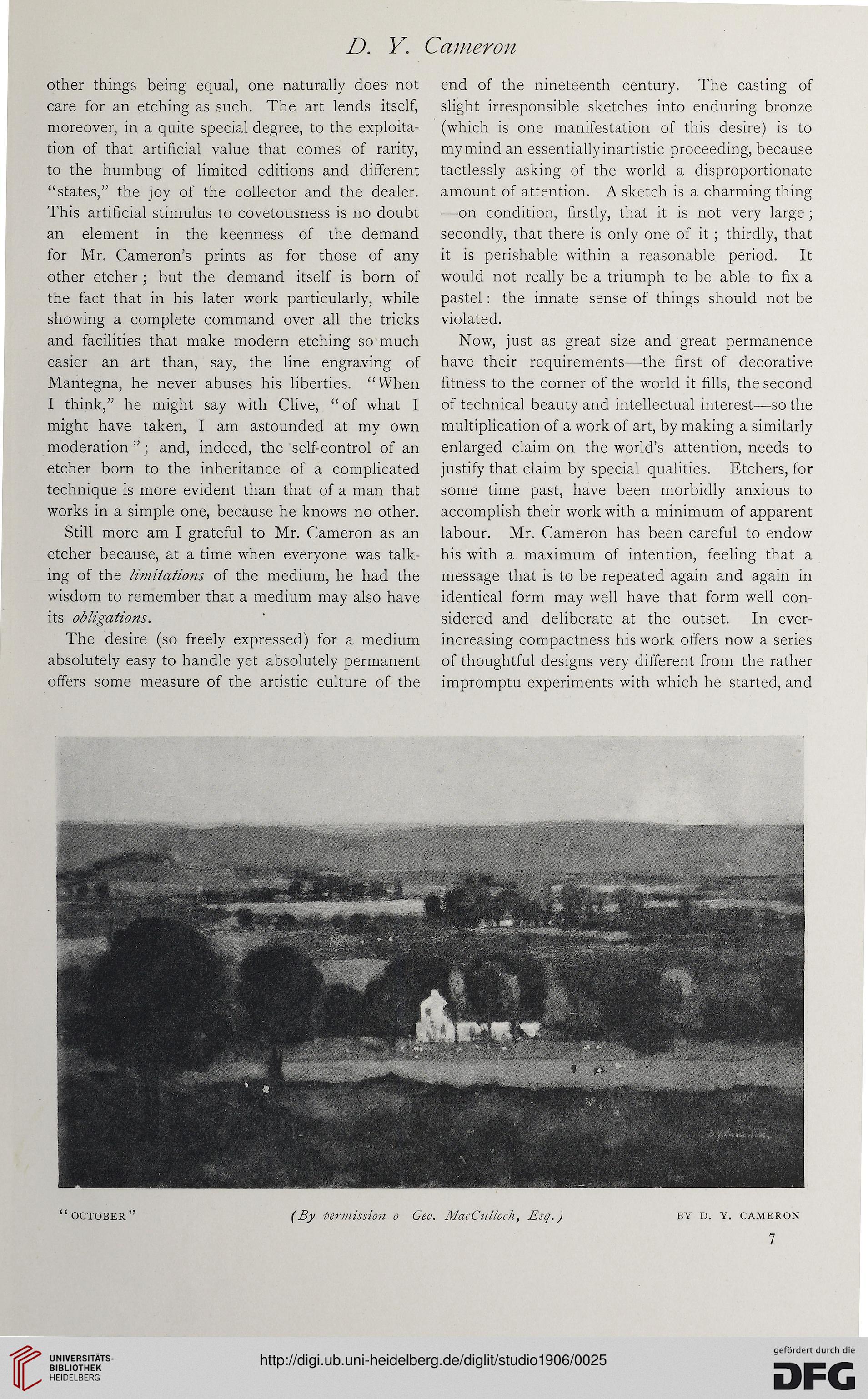D. Y. Cameron
other things being equal, one naturally does not
care for an etching as such. The art lends itself,
moreover, in a quite special degree, to the exploita-
tion of that artificial value that comes of rarity,
to the humbug of limited editions and different
“states,” the joy of the collector and the dealer.
This artificial stimulus to covetousness is no doubt
an element in the keenness of the demand
for Mr. Cameron’s prints as for those of any
other etcher; but the demand itself is born of
the fact that in his later work particularly, while
showing a complete command over all the tricks
and facilities that make modern etching so much
easier an art than, say, the line engraving of
Mantegna, he never abuses his liberties. “ When
I think,” he might say with Clive, “of what I
might have taken, I am astounded at my own
moderation ”; and, indeed, the self-control of an
etcher born to the inheritance of a complicated
technique is more evident than that of a man that
works in a simple one, because he knows no other.
Still more am I grateful to Mr. Cameron as an
etcher because, at a time when everyone was talk-
ing of the limitations of the medium, he had the
wisdom to remember that a medium may also have
its obligations.
The desire (so freely expressed) for a medium
absolutely easy to handle yet absolutely permanent
offers some measure of the artistic culture of the
end of the nineteenth century. The casting of
slight irresponsible sketches into enduring bronze
(which is one manifestation of this desire) is to
my mind an essentially inartistic proceeding, because
tactlessly asking of the world a disproportionate
amount of attention. A sketch is a charming thing
—on condition, firstly, that it is not very large;
secondly, that there is only one of it; thirdly, that
it is perishable within a reasonable period. It
would not really be a triumph to be able to fix a
pastel: the innate sense of things should not be
violated.
Now, just as great size and great permanence
have their requirements—the first of decorative
fitness to the corner of the world it fills, the second
of technical beauty and intellectual interest—so the
multiplication of a work of art, by making a similarly
enlarged claim on the world’s attention, needs to
justify that claim by special qualities. Etchers, for
some time past, have been morbidly anxious to
accomplish their work with a minimum of apparent
labour. Mr. Cameron has been careful to endow
his with a maximum of intention, feeling that a
message that is to be repeated again and again in
identical form may well have that form well con-
sidered and deliberate at the outset. In ever-
increasing compactness his work offers now a series
of thoughtful designs very different from the rather
impromptu experiments with which he started, and
7
other things being equal, one naturally does not
care for an etching as such. The art lends itself,
moreover, in a quite special degree, to the exploita-
tion of that artificial value that comes of rarity,
to the humbug of limited editions and different
“states,” the joy of the collector and the dealer.
This artificial stimulus to covetousness is no doubt
an element in the keenness of the demand
for Mr. Cameron’s prints as for those of any
other etcher; but the demand itself is born of
the fact that in his later work particularly, while
showing a complete command over all the tricks
and facilities that make modern etching so much
easier an art than, say, the line engraving of
Mantegna, he never abuses his liberties. “ When
I think,” he might say with Clive, “of what I
might have taken, I am astounded at my own
moderation ”; and, indeed, the self-control of an
etcher born to the inheritance of a complicated
technique is more evident than that of a man that
works in a simple one, because he knows no other.
Still more am I grateful to Mr. Cameron as an
etcher because, at a time when everyone was talk-
ing of the limitations of the medium, he had the
wisdom to remember that a medium may also have
its obligations.
The desire (so freely expressed) for a medium
absolutely easy to handle yet absolutely permanent
offers some measure of the artistic culture of the
end of the nineteenth century. The casting of
slight irresponsible sketches into enduring bronze
(which is one manifestation of this desire) is to
my mind an essentially inartistic proceeding, because
tactlessly asking of the world a disproportionate
amount of attention. A sketch is a charming thing
—on condition, firstly, that it is not very large;
secondly, that there is only one of it; thirdly, that
it is perishable within a reasonable period. It
would not really be a triumph to be able to fix a
pastel: the innate sense of things should not be
violated.
Now, just as great size and great permanence
have their requirements—the first of decorative
fitness to the corner of the world it fills, the second
of technical beauty and intellectual interest—so the
multiplication of a work of art, by making a similarly
enlarged claim on the world’s attention, needs to
justify that claim by special qualities. Etchers, for
some time past, have been morbidly anxious to
accomplish their work with a minimum of apparent
labour. Mr. Cameron has been careful to endow
his with a maximum of intention, feeling that a
message that is to be repeated again and again in
identical form may well have that form well con-
sidered and deliberate at the outset. In ever-
increasing compactness his work offers now a series
of thoughtful designs very different from the rather
impromptu experiments with which he started, and
7




